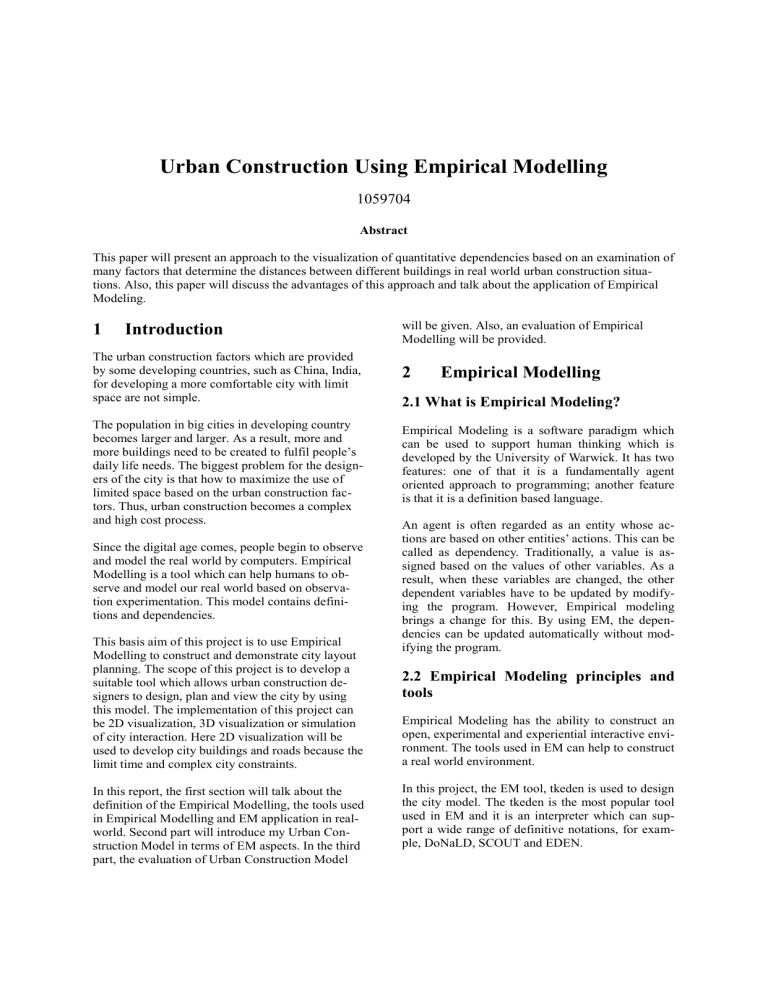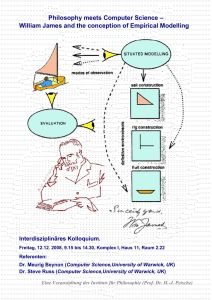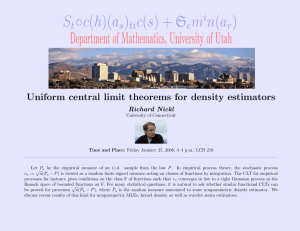Urban Construction Using Empirical Modelling 1059704
advertisement

Urban Construction Using Empirical Modelling 1059704 Abstract This paper will present an approach to the visualization of quantitative dependencies based on an examination of many factors that determine the distances between different buildings in real world urban construction situations. Also, this paper will discuss the advantages of this approach and talk about the application of Empirical Modeling. 1 Introduction The urban construction factors which are provided by some developing countries, such as China, India, for developing a more comfortable city with limit space are not simple. The population in big cities in developing country becomes larger and larger. As a result, more and more buildings need to be created to fulfil people’s daily life needs. The biggest problem for the designers of the city is that how to maximize the use of limited space based on the urban construction factors. Thus, urban construction becomes a complex and high cost process. Since the digital age comes, people begin to observe and model the real world by computers. Empirical Modelling is a tool which can help humans to observe and model our real world based on observation experimentation. This model contains definitions and dependencies. This basis aim of this project is to use Empirical Modelling to construct and demonstrate city layout planning. The scope of this project is to develop a suitable tool which allows urban construction designers to design, plan and view the city by using this model. The implementation of this project can be 2D visualization, 3D visualization or simulation of city interaction. Here 2D visualization will be used to develop city buildings and roads because the limit time and complex city constraints. In this report, the first section will talk about the definition of the Empirical Modelling, the tools used in Empirical Modelling and EM application in realworld. Second part will introduce my Urban Construction Model in terms of EM aspects. In the third part, the evaluation of Urban Construction Model will be given. Also, an evaluation of Empirical Modelling will be provided. 2 Empirical Modelling 2.1 What is Empirical Modeling? Empirical Modeling is a software paradigm which can be used to support human thinking which is developed by the University of Warwick. It has two features: one of that it is a fundamentally agent oriented approach to programming; another feature is that it is a definition based language. An agent is often regarded as an entity whose actions are based on other entities’ actions. This can be called as dependency. Traditionally, a value is assigned based on the values of other variables. As a result, when these variables are changed, the other dependent variables have to be updated by modifying the program. However, Empirical modeling brings a change for this. By using EM, the dependencies can be updated automatically without modifying the program. 2.2 Empirical Modeling principles and tools Empirical Modeling has the ability to construct an open, experimental and experiential interactive environment. The tools used in EM can help to construct a real world environment. In this project, the EM tool, tkeden is used to design the city model. The tkeden is the most popular tool used in EM and it is an interpreter which can support a wide range of definitive notations, for example, DoNaLD, SCOUT and EDEN. DoNaLD DoNaLD is short for Definitive Notation for Line Drawing and it is an Empirical Modeling definitive notation for 2D line drawing. By using DoNaLD, a shape can be displayed in the form of line drawing. Each shape can be modeled as a unique graphical object on the screen. Rather than absolute terms, DoNaLD allows each shape has its location and dimension defined in relative. By this way, modeling problem becomes much more convenient and immediate. In Urban Construction model, each shape is able to be defined in terms of each other. As a result, the model can provide a dynamic feeling to the users so that they are convenient to interact within the model. sult, people can learn and understand the real world situations. The dependency based approach allows the user to add some new functionality to the programming when it is executing. Changes to existing definitions can take effect immediately without modifying the program. As a result, the user can iteratively construct a model. With this model, people can achieve a human computing interface for designing of a comfortable city. The model can be analyzed by three aspects: observables, dependency, and agency. Observables In EM, all entities whose state can be observed by experiment can be regarded as observables. In Urban Construction model, the observables are the different city components such as high school building, banking building, car parking place, garden, traffic lights, bridge and roadways. Dependency In EM, the dependency defines the constraints and relationships between observables. In developing countries, the list of dependencies in urban construction is given by guidelines and restrictions from the government. Agency In EM, agency means anything which changes the current state of observables or entities in the model. In urban construction model, the agents can be the designers and the modelers of the city. SCOUT SCOUT is short for Screen layOUT which is a definitive notation used for describing the geometry and layout of windows on a screen. It can definite an interface between the output of other definitive notations and the actual display. In Urban Construction model, the SCOUT has two functions: first is to provide a view port window to the city and control the placement of different components; second is to show error message below the display window. EDEN EDEN is a general purpose language which used to support a definitive script to monitor certain aspects of the developed model. EDEN is not a pure definitive language but combines hybrid language and procedural programming. The statement used in EDEN can be a definition or a procedural style statement. When a definition or a statement being executed, an expression will be evaluated, a procedure will be called or a value will be assigned. On the other hand, the syntax used in EDEN can be regarded as a subset of C with some extensions. In Urban Construction model, the EDEN is used to examine and control the observables between different city buildings and road ways. 2.3 Real-World Application By using observation, EM can construct an open, experiential and experimental real world environment. By modelling state, EM can provide a pre-theory experimentation approach when some knowledge is incomplete. As a re- 3 Underlying Urban Construction Model As mentioned briefly in the introduction, the designers of the city need to consider many urban construction factors. In the real world, the dependencies between these construction factors are much more complex. My model only considers a small scope of these factors. Following are the factors which will be considered in Urban Construction Model: High school The distance between road way and high school is a factor needs to be considered in urban construction design. The high school is not allowed to be too close to road way because the students in high school need to have a quiet and comfortable study environment. Also, the high school should be close to the garden because it is a nice place for students to spend their leisure time. Car Parking The place for car parking needs to be close to the road way so that the drivers are easy to find a place to park a car. However, in order to avoid traffic jam, the car parking place is not allowed to be too close to the roadway. Garden The garden should be close to the high school because it is a nice place for students to spend their leisure time. Bank The bank should be near the bridge for customers’ convenience. Traffic Light The traffic light should be between the first road way and the second road way. Bridge The bridge should be between the first road way and the second road way. On the other hand, it cannot be too far away from bank. Two Road Ways In this model, the distance of two road ways cannot be too close. bank, or roadways are moved, the error messages can give an understanding of constructing rules for users. The implementation can give a sufficient proof that EM has the potential to make contribution towards city construction and development. The aim of this model is to represent modellers and designers a relevant and consistent model environment to help them construct a comfortable city. This model can interpret and understand the modellers and designers’ actions and requirements from all points of view. Figure 1 the screenshot of the operation of Urban Construction model. The scope of this model is to set up the dependencies between different components such as high school building, garden, bank building, traffic lights and roadways etc. All of these components have dynamic allocations and can be changeable based on designers’ requirements. With the model, the user can feel free to move and modify the components depending on constraints and dependencies. There are three main sections in the model: the city overview window, the control button and the error message. The city overview window allows user to observe the construction of city and the distance of different buildings. 4 Evaluation 4.1 Evaluation on Urban Construction Model The model has already tested by using many parameters to change the environment state. The final urban construction model provides a successful conceptual representation with functional dependencies. When the components such as high school building, Following is the screenshot of the operation of Urban Construction model. 4.2 Evaluation on Empirical Modelling Advantages of using Empirical Modeling One of advantages of EM is that it provides a better understanding of relationships present in the components being modelled. For example, in this Urban Construction model, the user can easily design the city by understanding the construction rules. The construction rules define the relationships between different components in the model. Another advantage of EM is the tool of EDEN leads itself to prototyping. In EM, the definitions can be redefined and the dependencies can be updated automatically. The using of dependency in EM makes users to be possible to build up software piece by piece. As a result, the components can be interacted with each other in real time. The real time is a useful feature for prototyping. It becomes possible for variables and dependencies to be changeable in EM. In addition, new components can be added into model. The third advantage of EM needs to be mentioned is that, as a definition based language, the tool of EDEN doesn’t have a thread of execution process as those traditional tools. In EM, procedures and functions can be triggered when any values of related definitions or variables changes. The final advantage of EM is that the definitive notations, such as DoNaLD and SCOUT, is easy to be understood and used. Based on my own experiment on developing the Urban Construction model, it takes very short time to learn and understand the syntax. Compared with traditional procedural system, it allows users to easily add new components without updating all the related definitions. Disadvantages of using Empirical Modeling The biggest problem of EM is its immaturity. When modifying the Urban Construction model, many bugs existing in the interpreter and many unexplained events and crashes happened. The second disadvantage is that there is inconsistency existing in EDEN language. It is a trouble for accessing variables between extensions and constructing model. For example, it is a trouble to access EDEN list items. The third disadvantage for EM is that except three extensions which are for handling graphics, very few GUI widgets can be used. For example, people cannot use radio buttons or slider bars directly in EM. 5 Conclusion It is feasible and realistic to use Empirical Modeling to create an urban construction model. With the tools of DoNaLD, SCOUT and EDEN, EM can successfully provide a suitable prototype for developing a single model simultaneously. 6 References Meurig Beynon. Visualisation using empirical modelling principles and tools. University of Warwick, 2007. Meurig Beynon and Alan Cartwright. Agentoriented modelling for engineering design. University of Warwick, 1990. Chris Roe. Computers for Learning: An Empirical Modelling Perspective. PhD thesis, Department of Computer Science, University ofWarwick, November 2003. Meurig Beynon, Yun Pui Yung, and C. J. Sidebotham. Computer-assisted jigsaw construction: a casestudy in empirical modelling. University of Warwick, 1990. Valery Adzhiev, Meurig Beynon, Alan Cartwirght, and Yun Pui Yung. A new computer-based tool for conceptual design. University of Warwick, 1990. Edward Yung. EDEN: An Engine for Definitive Notations. MSc thesis, Department of Computer Science, University of Warwick, September 1989.







